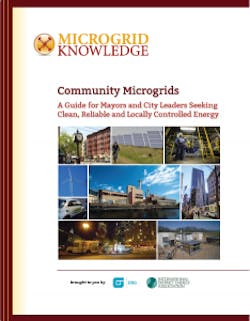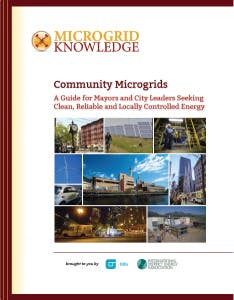A Community Microgrid that Beats Utility Rates: Bridgeport’s Story
Microgrids aren’t cheap. At least not yet. But it’s possible to design a microgrid that beats utility rates, even at this early stage of the industry.
That’s what Bridgeport, Connecticut found out as it cleaved a new path over two years developing a complex community microgrid. A new whitepaper describes the trek.
Spoiler alert. Some of the Bridgeport strategies rely on market conditions and incentives unique to the location. However, Bridgeport provides an example of the kind of thinking that goes into microgrid development. It’s the story of finding hidden economic potential through an iterative puzzling together of systems, assets and incentives.
Making the economics work was a long process, according to Fred Fastiggi, principal and managing director of New Jersey-based Shoreline Energy Advisor. But work they did.
Now under construction, the 1.045 MW City Hall Complex Microgrid is expected to begin producing electricity next summer below the rate charged by local utility, United Illuminating.
Along with the lower rate will come a new level of reliability for the city’s police station, city hall and a senior center. Such premium power typically costs far more than plain vanilla utility service.
Community microgrids: a different animal
Managing costs for a community microgrid — one built for a public purpose — can be particularly daunting. Cities and towns all have their own demands and objectives.
Community microgrids are “a different animal than traditional forms of distributed generation,” said Fastiggi, who worked on the project as the owner’s representative for the City of Bridgeport’s Energy Improvement District. He also authored the whitepaper.
Download the Microgrid Knowledge Community Microgrid Special Report
“There is no template for development of these projects and those undertaking them should be prepared for many twists and turns before arriving at a project which serves the needs of the host site at competitive cost, while offering investors a reasonable return on their capital,” Fastiggi said.
It is particularly hard to design a community microgrid that beats utility rates. And it was made harder for Bridgeport by some demanding state requirements.
The project received initial funding from the state microgrid grant and loan program. To secure the funding, the microgrid had to show it could:
- Serve multiple critical facilities (such as hospitals and police stations)
- Island from the grid and run continuously for at least four weeks with no help from the grid
Further, the state mandated that the microgrid offer enough capacity to meet peak power needs any time, day or night, winter or summer. This diverges from the usual way of sizing distributed generation. Most projects are built to meet lower, base load requirements — a facility’s minimum power need.
The peaking requirement made the microgrid “very expensive to build,” said the whitepaper.
The developer had to somehow come up with a microgrid that met the state requirement at a cost in keeping with public sector expectations. Yet at the same time, the microgrid had to offer the kind of fail safe quality typically reserved for air traffic control stations, the military, data centers and others willing to pay high prices in exchange for high electric reliability.
“In the past, critical power energy users thought nothing of paying forty or fifty cents per kWh or even in excess of a dollar per KWH, as long as power was available when needed,” said the white paper.
In contrast, Bridgeport had to get below 17 cents/kWh to build a microgrid that beats utility rates.
Virtual net metering to the rescue
The microgrid would cost $7.475 million to build, leaving a big gap between what the state would fund, $2.975 million, and what it would cost. The project was able to secure financing from a private bank and Connecticut’s green bank.
Project players: Connecticut-based OR&L Construction was chosen to develop, design, construct, own and operate the Bridgeport microgrid in partnership with Good Energy and Power Island. The microgrid’s natural gas generators came from Ener-G Rudox and include a natural gas engine from Man Engines.
In addition to providing electricity, an early design of the microgrid channeled heat and hot water to the police station and city hall. It did so by reusing generator waste heat via a combined heat and power (CHP) system, a technology that reduces fuel requirements.
Despite the efficiency created by the CHP system, the microgrid produced electricity at more than 20 cents/kWh. The project designers began casting about for innovative solutions.
They found the first answer in Connecticut’s virtual net metering program. Virtual net metering allows a facility unconnected to the microgrid to use the microgrid’s excess generation virtually – basically a credit on paper. The microgrid had excess capacity since it was built to serve peak, not normal, system demand.
But the project had to seek regulatory approval to participate in the virtual net metering since the program was set up originally for solar projects. When the Connecticut Public Utilities Regulatory Authority okayed the application, the project netted an additional $379,680 annually.
The cost of the microgrid’s power then dropped between 17 and 20 cents/kWh. It still could not be described as a microgrid that beats utility rates.
[clickToTweet tweet=”Community #Microgrid Beats Utility Rates ” quote=”Community Microgrid Beats Utility Rates “]
More uses for waste heat
Connecticut is one of about 20 states that includes waste heat as a resource to meet renewable portfolio standards. This means, typically, that utilities must provide a certain amount of the resource or buy credits from others who do.
Selling CHP credits offered a significant revenue source for the microgrid, since credit prices are expected to range from $225 to $275 per MWh over the next three years, according to the white paper.
So the project designers then looked to the state’s renewable portfolio standard. But there was a glitch. To make the economics work, the project had to use more of its waste heat – more than was needed for hot water and heating to the police station and city hall. So they added an absorption chiller to the system. That transformed some of the waste into air conditioning.
In addition, the designers extended hot water piping to a nearby privately-owned building. The facility was being renovated into a health club, theater and retail and residential units. It was a perfect candidate for waste heat to warm its indoor pool and meet other heating and cooling demands.
Adding the new building significantly enhanced the system’s efficiency. That act, along with some other enhancements, dropped the microgrid to 16.85 – 17.65 cents/kWh.
So yes, it is possible to design a complex community microgrid that beats utility rates, even at this early stage of the industry, when it is still scaling up and developing efficiencies and standardization. As Bridgeport showed, it requires engineering ingenuity, creativity, and a willingness to persist.
Download the whitepaper “The Development and Evolution of the Bridgeport City Hall Complex Microgrid Project.”
About the Author
Elisa Wood
Editor-in-Chief
Elisa Wood is the editor and founder of EnergyChangemakers.com. She is co-founder and former editor of Microgrid Knowledge.

